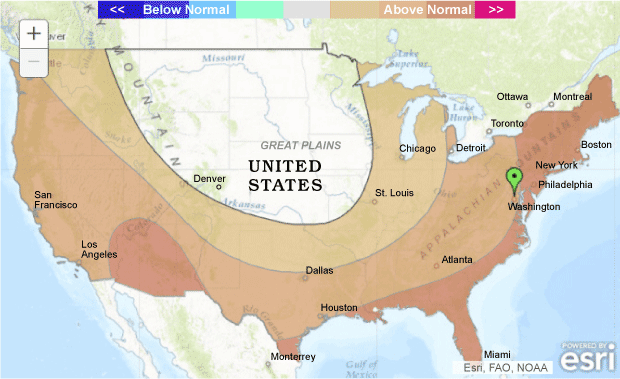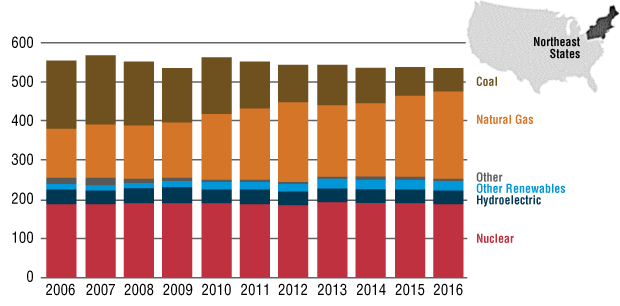
Cooling Season
Summer Forecast Calls For Warmer Temperatures
WASHINGTON–According to the National Oceanic & Atmospheric Administration, most of the United States is expected to experience hotter-than-normal temperatures this summer–from New York to Los Angeles, Miami to Seattle, and Chicago to Anchorage.
“Above-normal seasonal mean temperatures are most likely for the eastern United States, across the southern states, and west of the Rocky Mountains. The greatest odds are indicated for parts of the Southwest, the Gulf Coast, and the Atlantic Coastal regions. Above-normal temperatures also are favored for much of Alaska,” NOAA says in its 2017 Summer Outlook, noting that even Hawaii has a high probability of much warmer-than-usual summer weather.
Figure 1 shows the NOAA temperature forecast map for June, July and August. The colors show the areas where the chances of a warmer-than-average summer exceed 33 percent. The darker the color, the greater the chances of hotter temperatures. The Great Plains and northern Rockies (shown in white) are the only sections of the country where the NOAA forecast calls for equal possibilities of a colder-than-normal, near-normal, and hotter-than-normal summer.
The areas with predicted above-average summer temperatures correspond with the parts of the country that contain the largest regional markets for electricity generated using natural gas, according to data from the U.S. Energy Information Administration. That includes the eight largest gas-fired electricity generation and consumption regions: South Atlantic, West South Central, Middle Atlantic, East South Central, East North Central, Pacific, Rocky Mountain and New England. These eight regions collectively accounted for 97 percent of the 1.2 trillion cubic feet of natural gas consumed for electricity generation in August 2016, and 98 percent of all utility-scale electricity generated that month using natural gas.
Based on NOAA’s climatological probabilities for select cities, New York City has a 55 percent chance of experiencing well above-average temperatures this summer, compared to a 33 percent chance for average and a 12 percent chance of well below-average temperatures. Los Angeles and El Paso, Tx., each have a 48 percent probability of well above-average conditions, while Chicago has a 38 percent chance.
The agency defines “well above” as ranking in the upper one-third of the 30-year average of June, July and August temperatures recorded between 1981 and 2010. “A couple of degrees difference in the summer average is likely to smooth out a big difference in daily heat extremes,” NOAA states.
Regional Variations
A summertime outlook from The Weather Company, an IBM business, also forecasts above-average temperatures across most of the nation, but with some regional variations. June holds the greatest chance for warmer-than-normal temperatures for the Northeast region, according to the forecast, with above-average temperatures also likely in the Southeast and West during the month.
In July, temperatures are expected to be well above-average from northern California into western Washington, with warmer-than-normal temperatures stretching from Southern California across the Rockies and into Texas and Oklahoma. “The expanse of hotter-than-average temperatures will grow in August, stretching from the West Coast through the Plains and into parts of the Midwest and Southeast,” the forecast states. “The area from southern California into New Mexico and western Texas may see temperatures soar well above average.”
Contrasting the NOAA forecast, however, The Weather Company predicts cooler-than-average July temperatures in the Upper Midwest, Ohio Valley and eastern Great Lakes, with near-average to slightly above-average temperatures in the Southeast. In August, The Weather Company says it sees average to slightly below-average temperatures in the Northeast, with average to slightly above-average temperatures in the Atlantic and Great Lake regions.
The American Gas Association, which begins tracking the U.S. cooling season at the start of May, reported that temperatures had already averaged 33 percent warmer than normal through the first three weeks of the month, particularly in the Middle Atlantic and Northeast regions. “Only the Mountain region was cooler than normal,” AGA says.
The springtime warmth was reflected in EIA data for the third week of May, which showed six fewer heating degree days but 30 more cooling degree days than the historic average. “In particular, the South Central region, which can have considerable gas-fired electric generation demand, reported warmer-than-normal temperatures,” EIA explains, noting that the warmer temperatures resulted in increased power burns. “Temperatures in the East South Central division averaged 4 degrees Fahrenheit higher than normal, and temperatures in the West South Central division averaged 2 degrees higher than normal.”
Natural Gas Demand
Hotter summer temperatures are obviously bullish for seasonal natural gas demand. According to EIA, natural gas will again fuel the lion’s share of electricity generation between June and August–the third consecutive summer in which natural gas is expected to reign as the dominant form of power generation. EIA projects that natural gas will maintain an average 34 percent share of total U.S. generation this summer, exceeding coal’s 32 percent share.
Natural gas continues to displace coal in the power generation market in virtually all parts of the country. Last summer, EIA says 37 percent of total U.S. electricity generation came from natural gas and 33 percent from coal. By comparison, in the summer of 2006, only 25 percent of total electricity generation came from natural gas and 46 percent from coal.
In the Northeast region, EIA reports that natural gas nearly doubled its share of total electricity generation between 2006 and 2016–from 23 to 41 percent (Figure 2). “The generation fuel mix of electricity in the Northeast has shifted dramatically over the past 10 years,” EIA states. “Increased access to low-cost natural gas from the Marcellus and Utica shale plays has driven the switch away from coal in the Northeast United States.”
The agency says coal-fired generation declined by more than 60 percent in nine Northeast states over the 10-year period, falling from 31 to 11 percent of total generation. While Pennsylvania continues to be a leading coal generator nationally, the commonwealth’s coal-fired output fell 31 percent (68 million kWh) between 2006 and 2016. Meantime, EIA points out that Pennsylvania was expected to add 1.8 gigawatts of new gas-fired capacity between 2016 and 2018 alone. Nationwide, 18.7 gigawatts of new natural gas generation capacity were on track to enter service between 2016 and 2018.
For the week ending May 24, the 2.44 Tcf of working gas in storage was 371 billion cubic feet (13 percent) lower than last year at the same time, but still 241 Bcf (11 percent) above the five-year average, EIA reported. For the same week, the agency said total U.S. dry natural gas production was 70.9 Bcf/d, down 1 Bcf/d from one year earlier and 3 Bcf/d from two years earlier.
For other great articles about exploration, drilling, completions and production, subscribe to The American Oil & Gas Reporter and bookmark www.aogr.com.








